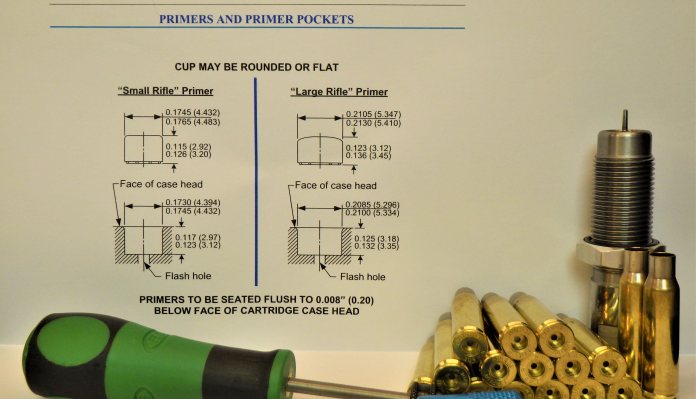RELOADING BASICS – Check your flash hole
-
0
 Comments
Comments
- Last updated: 08/01/2024

The flash hole, which is that tiny little hole between the primer cup and the inside of the case, may seem insignificant, but it has a direct impact on your ammunition. The function of the flash hole is to allow the flash generated by the struck primer to ignite the powder charge as quickly and efficiently as possible and to prevent any back pressure from rupturing the primer.
Flash hole size
The diameter of flash holes varies from manufacturer to manufacturer, and SAAMI, which sets the international standards for ammunition and chamber dimensions, does not appear to set a standard size. Most American brands of cases have flash holes in the region of 0.060” to 0.080” and standard Lee Precision decapping pins are around 0.062” in diameter.
Other brass manufacturers produce cases with smaller flash holes, and Lapua produces some with holes significantly smaller at 0.030” (Lee Precision produces a decapping mandrel specifically to deal with this brand’s smaller flash holes). If you have attempted to deprime certain Lapua cases with a standard depriming pin, you may have experienced significant issues and even encountered a bent pin.
There is a lot of science and extensive testing behind manufacturers choosing a particular diameter, and they are best left as manufactured.
Oversized flash holes
It is not recommended that you change the diameter of the flash hole from the as-manufactured size. Undersized flash holes can be drilled out using a 1.6mm diameter bit or reamed out using one of the flash hole uniforming tools available from various manufacturers, with the latter option being the easiest and most accurate. This will make them large enough to take a standard depriming pin, but you should not increase the size significantly.
Although some might think that the larger the flash hole the quicker and ‘better’ the ignition of the powder charge, this is actually flawed thinking. The manufacturers have done extensive research and testing to establish the safest and best way to ignite the charge. If the flash hole is enlarged, more of the chamber pressure will be permitted to push back against the primer and, in extreme cases, it can blow the primer out or pierce it and release pressure onto the breach face. This can result in damage to the gun and injury to the shooter.
If you do drill out your flash holes to a larger size, the reloading data you use (that usually states the brand of case used in producing the data) will no longer be valid, because you have changed one of the criteria that it was based on - a specific sized flash hole. It is possible that you could change the pressure curve to a point where it peaks beyond the safe pressure curve for your gun.
Consistency
As with all aspects of reloading, consistency is the key to quality ammunition, and flash holes are no exception. They must all be the same size so that powder ignition and chamber pressure are the same from round to round. The flash holes from any given manufacturer will normally be consistent in a batch of cases. So, as long as you do not mix different brands of cases, your reloads should be consistent in this respect.
Preparation and maintenance
Flash holes are usually punched out by a machine, and before you use cases for the first time, it is well worth checking and tidying them up. The production process often leaves burrs and small pieces of brass around the holes, which need clearing and regularising. Flash hole deburring tools have a cutting edge that is introduced into the case, via the mouth, to cut away any excess metal around the flash hole in order to standardise them.
When you have deprimed your cases and cleaned them, it is always a good idea to check them over for cracks etc. and check the flash holes. Small pieces of debris, usually gunpowder or primer residue, can occasionally get stuck in the flash hole and should be removed. Also, if you have a case cleaner that uses a cleaning media like ground-up walnut shells, pieces of cleaning media can get lodged in the flash hole and they need to be removed too. A small tool like an old dentist’s pick is ideal for this job.
Tools
The RCBS Flash Hole Deburring tool uses a calibre-specific collar to centralise a cutting head that deburrs the flash hole from the inside of the case. Only minimal pressure is required to remove any bits of brass from new cases to make the holes more consistent. The collar on the tool sits in the case mouth and is set to the correct case length.
The excellent K+M Professional Flash Hole Uniformer deburrs the inside face of the flash hole and bores it out to a standard 0.080” diameter. It is very easy to use and produces very neat and consistent flash holes.
Conclusion
Consistency is a word you will hear again and again when reading about reloading, and it applies to flash holes just as much as it does to powder charges or the cartridge’s overall length. When you start reloading a new batch of cases, it is always a good idea to check and deburr all the flash holes. You should not alter or overly enlarge the holes in any way, as this can be very dangerous, they are that size for a reason. If you switch your standard load to or from a brand like Lapua, which makes certain cases with smaller flash holes, and keep everything else the same, your point of impact on target will change. This shows just how significant flash hole size is and proves that it is a potential variable that needs to be kept consistent.
